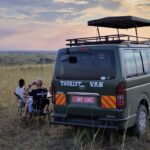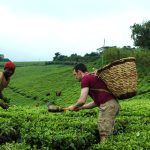Going to Uganda for gorilla tracking after Kenya is the best way for travelers to enjoy the best of what East Africa’s wilderness has to offer – the great migration and endangered mountain gorillas.
Gorilla trekking involves hiking the steep slopes, deep into the thick rainforests of Uganda, Rwanda, and DR. Congo. As a travel experience, seeing gorillas is mind-blowing, humbling, and satisfying in a way that cannot be compared. This is why many tourists from all around the world come to see mountain gorillas in their natural habitat.
Besides gorilla trekking, East Africa is blessed with a warm climate and open savannahs that are home to millions of wild animals. Whether it is Kidepo, the Serengeti, or the Masai Mara the abundant wildlife stands true to the fact that East Africa is where wildlife-viewing safaris were born.
Many travelers have expressed interest to visit not just the gorillas but the wildlife of Kenya – especially the great migration of millions of animals in the Masai Mara. We have some itineraries that show how a trip can easily combine visiting both Uganda and Kenya.
This article will serve to provide some insight into all that you would need to know – and show you the possibility and ease of doing gorilla tracking after Kenya.
A Guide to Gorilla Tracking after Kenya
Moving from Kenya to Uganda
There are several ways for you to move from Kenya to Uganda for gorilla trekking. Depending on your preferences, you can use the roads or flights to Uganda.
The best alternative is to fly from Masai Mara to Entebbe in Uganda via Kisumu using Airkenya. The flight takes a total time of around 3 hours to reach Entebbe International Airport in Uganda.
If your safari in Kenya happens to be in the other parks and attractions, you will find easy domestic flights that will connect you to Masai Mara for the above-mentioned flight schedule to Entebbe.

Alternatively, one can choose to drive from Nairobi in Kenya to Bwindi in Uganda. This is an extremely long drive that makes sense if the entire trip involves several stopovers to explore the countryside and villages in Western Kenya and Eastern Uganda.
As a single-destination drive, this will be extremely tiresome and even the beautiful countryside will quickly become boring.
This long drive can also be done using the daily passenger buses that move from Nairobi to Kampala and then to Kigali. While this is doable, it is the least ideal way for most people to go about the whole process.
We recommend flying to Entebbe and then continuing to Bwindi Impenetrable and Mgahinga National Parks – the home of gorillas.
Where to see gorillas in Uganda
While Mountain gorillas can be seen in both D.R. Congo and Rwanda – in addition to Uganda, Uganda has the highest number of gorillas. This is because Uganda has 2 national parks where gorillas live freely in the wild.
Therefore, in Uganda, you will be able to see gorillas in the wild in Mgahinga Gorilla National Park as well as Bwindi Impenetrable National Park – both located in Southwestern Uganda.
During the process of planning and finalizing the details of your trip, the national park and tracking sector are chosen based on your own preferences and trip specifics. We then buy the gorilla permits on your behalf ahead of time, to make sure everything is ready for you.

Getting to the Mountain Gorillas.
There are 2 ways for you to get to the mountain gorillas in Southwestern Uganda. You can choose to fly from Entebbe to Kihihi or Kisoro. Alternatively, you can drive from Entebbe or Kampala to Bwindi or Mgahinga.
For flying, there are daily local flights from Entebbe to Kisoro Airstrip or Kihihi Airstrip. From there, a drive to your lodge will take between 1 and 3 hours depending on where you land and where you are booked to stay. This is a great option for people who wouldn’t want to undertake the long drive.
For driving, it is a day’s drive to move from Kampala to Bwindi or Mgahinga. To make the drive more interesting, brief stops are planned along the way from Kampala. The Ugandan countryside is beautiful and going through the small towns, roadside markets, banana plantations, ranches, and changing landscape is quite enjoyable.
Depending on the specifics of your safari, you might be stopping at other attractions before proceeding to see the mountain gorillas. Our safari consultants will advise you on every detail of how you can get to the gorillas for your encounter.
Cost of gorilla tracking
 The cost of gorilla trekking differs from country to country and if you are planning to do gorilla trekking in any of the three destinations, you will need to acquire a gorilla permit which is basically a document that allows you to access the gorillas.
The cost of gorilla trekking differs from country to country and if you are planning to do gorilla trekking in any of the three destinations, you will need to acquire a gorilla permit which is basically a document that allows you to access the gorillas.
In Uganda, gorilla permits cost $700, in Rwanda $1500, and in Congo $400. And if you are an East African national, you can obtain a gorilla permit in Uganda for 250,000 Uganda shillings.
It is important to note that the price of gorilla permits is just a fraction of the overall cost of a gorilla-tracking safari. The cost of the whole gorilla trekking experience will also depend on several other factors like the type of accommodation (Luxury, mid-range, or budget), food, activities, transport, packing lists, porters, and tips for the Guides among others.
Our trips are oftentimes all-inclusive packages that take care of all the details once the guests start their safari.
Due to the specifics of a given trip, the cost can change based on many factors. The best way to get a satisfactory price is by working with the tour operator to figure out your specific needs and how to fit them into your budget.
Related article: Cost of an African Safari
Accommodation options

Different lodging options are strategically set up for gorilla trekking in Bwindi ranging from budget, and mid-range to luxury accommodation.
Whether you want to camp under the cold starlit sky of Bwindi/Mgahinga or you prefer a dash of luxury, you will not be lost for choice.
Related article: Accommodation for tourists in Uganda
The best time to visit both Kenya and Uganda
Generally, both Uganda and Kenya enjoy a warm and sunny climate all year round with comfortable temperatures. In both countries, the seasons are differentiated by rain. It is either a dry season with little to no rain or a wet season with regular showers.
For gorilla trekking, the difference in seasons makes the hiking trails a bit more slippery but being a rainforest, the dry season doesn’t guarantee dry days.
For wildlife viewing in the savannah, the dry season forces wild animals to congregate near water sources which can be great for seeing animals in big numbers.
The best time to visit both Uganda and Kenya – including gorilla tracking is therefore during the dry season months from June to October. If you are interested in witnessing the great migration in Masai Mara, September and October might be the best months.
Depending on the movement of the animals in the Serengeti, this can change. During the planning of your trip, the most recent information can be used to plan your visit at the most ideal times.
Related article: Uganda’s Climate & Weather
Visa Requirements
Visiting both Kenya and Uganda has become much easier since the introduction of the East African Tourist Visa. The visa allows you multiple entries into Uganda, Kenya, and Rwanda.
You can apply for the East African Tourist Visa online via the various online visa portals for Kenya, Uganda, or Rwanda. For purposes of entering multiple countries, this visa is cheaper and saves you time in filling out multiple visa forms.
The online applications are quite straight forward and your visa will often be processed within 2 days.
Final Thoughts
Because of the great relationship that has always existed between Uganda and Kenya, traveling in both countries is quite easy. Additionally, it gives you the unique chance to see how the various cultures and people transition and morph into each other, a fact that usually goes unnoticed.
The two greatest wildlife experiences – gorilla tracking in the thick jungle and the great migration in the open savannah can be enjoyed in a single trip. We have several trips that combine these two experiences of a lifetime.
Gorilla tracking after Kenya is a much simpler addition to your African safari and we hope you can see that it is possible.
Look through for inspiration and send us a quick inquiry. We would love to talk and see what you have in mind for your safari.





















